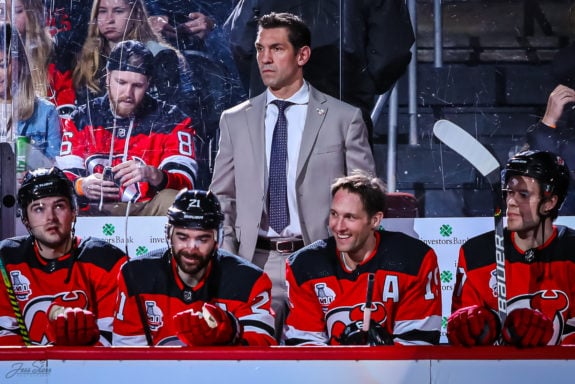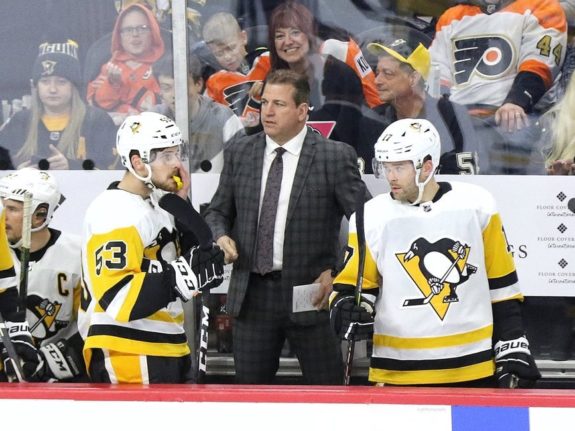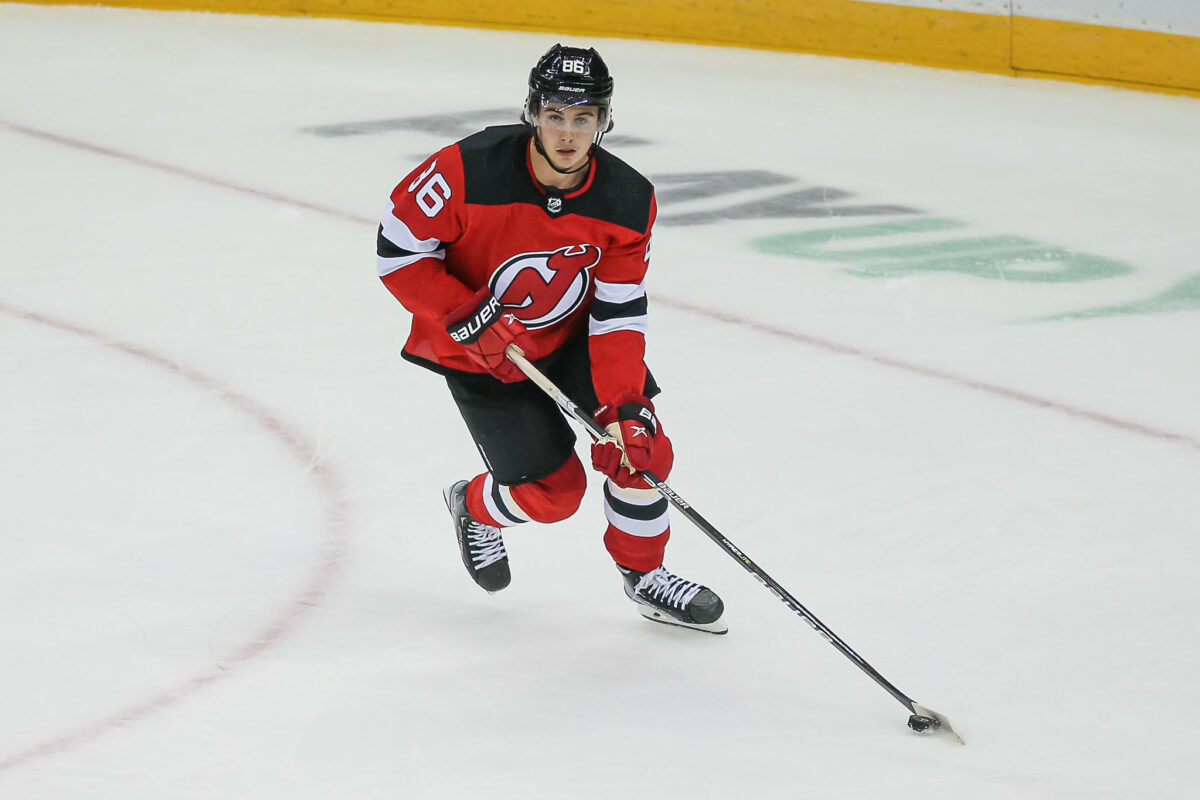It’s been a tough 2021-22 season for the New Jersey Devils. They have a 16-26-5 record and have been without healthy goaltenders for a good portion of the season due to injuries to Jonathan Bernier and Mackenzie Blackwood. But one thing they have going for them, specifically as of late, is their power play and penalty kill.
The Devils’ penalty kill has been a strength for most of the season, but it’s really clicked as of late. Their power play got off to a brutal start, but it’s turned it around since just before the Christmas break. They aren’t winning games because the team is struggling in other areas, but those units are giving the Devils something to build on in their final 35 games. Let’s dive in and look at why each unit is having success and see if each is sustainable.
Already a Strength, Penalty Kill’s Results Continue to Improve
Last season was an aberration in many ways for the NHL due to the pandemic. For the Devils, having one of the league’s worst penalty kills was their aberration. Before then, the Devils had finished in the top 10 in penalty kill percentage for three seasons and were even top five in 2018-19. In 2020-21, their penalty kill finished 31st in the NHL with a success rate of only 70.95 percent.
Fortunately, things have gotten plenty better from a season ago. With the halfway point of 2021-22 in the rearview mirror, the Devils have a penalty kill percentage of 82.4 percent, ranked 11th in the league. Their results are not flukey, either, as they’ve had one of the best penalty-killing units in the NHL for most of the season.
Through 47 games, the Devils are allowing 76.92 shot attempts per 60 minutes when playing down a man. Only the Toronto Maple Leafs (75.35) and Carolina Hurricanes (64.77) have suppressed shot attempts at a better rate. The results are about the same when it comes to quality as well. The Devils are allowing 5.35 expected goals per 60 minutes, the fourth-best rate in the league. Only the Hurricanes, Dallas Stars and Tampa Bay Lightning have suppressed quality shots at a better rate.

To add to that, the Devils’ penalty kill has been quite strong since just before the Christmas break. Since Dec. 18, they’ve killed off 34 of 38 power plays, a success rate of 89.4 percent. And that’s with a bit of an increase in the number of shot attempts per 60 (84.08) and xG per 60 (6.63) they’ve allowed.
Fortunately, they’ve gotten high-end goaltending on the penalty kill. Despite the five-on-five struggles in between the pipes, Devils goaltenders have a .940 save percentage (SV%) on the penalty kill since Dec. 18, the second-best mark in the league. That’s a bit unsustainable, so there’s probably some regression coming in that regard. But even with the slight increases in the number of quantity and quality shots they’re giving up per 60 minutes, they still rank in the top half among NHL penalty kills — sixth in shot attempts against per 60 and 13th in xGA/60.
Related: 3 Takeaways From the Devils’ Dominant 7-1 Victory Over the Canadiens – 02/08/22
Given that and how the Devils’ penalty kill has performed this season, there’s probably good reason to believe it can remain one of the better units for the rest of 2021-22, even if there’s some regression coming with their SV%. It’s one of the few things they’ve had going for them all season, and it’s been one of the best units in the league as of late, so it’s something to build on.
Devils Power Play Scoring Goals, But With a Catch
For those who have been following the Devils, you’re probably familiar with how much their power play struggled through the first two months of 2021-22. But for those who haven’t been following the team, here’s a quick rundown.
Along with the Arizona Coyotes, the Devils’ power play was among the league’s worst to start this season. The Devils converted on only 10 of their first 78 man-advantages, a success rate of 12.8 percent. It was also among the worst shot- and chance-generating power plays in the league, as they were averaging 83.81 shot attempts per 60 minutes and 5.02 xG per 60 minutes, ranked sixth- and third-worst in the NHL. Those numbers are similar to the Devils’ power play in 2020-21, which was Mark Recchi’s first year overseeing the unit.
But lately, the Devils’ power play has been much better, at least when it comes to converting — it’s 12 for its last 48, a success rate of 25 percent. Had their power play been scoring 25 percent of the time earlier in the season, especially when five-on-five goaltending was still holding up, their record would probably be a bit better than it is today.

With that said, the Devils’ power play hasn’t improved all that much during this current stretch that dates back to Dec. 18, at least when it comes to generating shots and chances. They’re averaging 85.6 shot attempts per 60 minutes, more or less the same as they were through Dec. 17. When it comes to xG, they’re averaging 6.25 xG per 60 minutes, ranked 22nd in the league. There’s been a bit of improvement in that regard, but it’s not that significant of a bump.
The main reason the Devils’ power play has started converting is that they’re riding a shooting percentage of 23.53 percent, the highest mark in the league since Dec. 18. That’s not particularly sustainable, and it will regress eventually. At the same time, there are probably a couple of different factors to consider as to why it may continue to have some success.
Bastian and Hughes Making a Difference on the Power Play
For starters, the Devils’ power play has looked much better with Nathan Bastian as a net-front presence on the first unit. He’s scored a couple of goals on redirects and has also done a good job of taking away goalies’ line of sight. He’s made a difference in puck retrievals and battles along the boards, which was a significant problem early on. His first game on the power play came on Dec. 19, so it’s probably not a total coincidence they’ve converted on 25 percent of their power plays since then.
Related: Top 10 Highest Scoring NHL Games of the Modern Era
The second is the return of Jack Hughes from a dislocated shoulder. He rejoined the lineup a little bit before American Thanksgiving, but it took him a little while to get back up to speed. He started to turn things around just before the extended Christmas break and has been on a tear since then. On the power play, Hughes has seven points since Dec. 18, with six of those being primary points (goals and primary assists). Other than Jesper Bratt, he’s the team’s best playmaker and can create chances with royal-road passes that xG models might not be able to account for due to limits in tracking data.

Because of Hughes and Bastian, perhaps the Devils can sustain a bit of that shooting luck. But there will be regression at some point. Even the best power plays in the league usually finish the season shooting around 14-17 percent. The same applies to the penalty kill and SV% eventually leveling off.
But even then, both units have given the Devils something to build on over their final 35 games of 2021-22. They aren’t making the playoffs. They don’t even have a remote chance. But they are the youngest roster in the NHL and need to find a way to win some games to end this season. Even if special teams regress to league average or a bit above league average from where they’ve been since Dec. 18, they could win some games if they somehow manage to get better goaltending at five-on-five. It won’t mean anything for this season, but it could give players like Hughes, Bratt and Nico Hischier something good to feel about heading into 2022-23 when the team needs to get off to a strong start.
* * *
Advanced stats from Natural Stat Trick